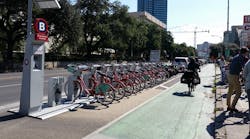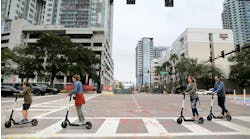The National Association of City Transportation Officials’ 2022 Shared Micromobility Report details bike share, e-scooters and other micromobility systems have become integral to city transportation networks across North America, with at least 130 million trips on micromobility systems in the U.S. and Canada in 2022.
The number of micromobility trips in the U.S. and Canada increased by 5 million from 2021 and are up by 40 percent since 2018. In the U.S., shared micromobility continued its pandemic-era recovery, with 113 million trips in 2022 while ridership in Canada blew past pre-pandemic highs with 17 million trips.
The report also highlights notable trends in the usage of shared micromobility. Even as 9 a.m. to 5 p.m. commute patterns return, the report shows people are using shared micromobility for far more than just work trips, as an analysis of large systems found 34 percent of riders use shared micromobility to access jobs while 39 percent use shared micromobility to run errands, 16 percent to get to school and 50 percent for other social or recreation trips.
According to the report, the e-bike boom has also continued to grow, with 75 percent of all station-based systems across the U.S. and Canada expanding the number of e-bikes in their fleets, and in the U.S. alone, total station-based e-bike trips increased from 14.5 million trips in 2021 to 20 million trips in 2022. Station-based e-bikes made up only nine percent of available shared micromobility devices in the U.S. and Canada in 2022, yet accounted for 18 percent of total trips.
“Shared bikes and e-scooters are a key part of daily life for communities across North America,” said Corinne Kisner, executive director of NACTO. “We cannot take this success for granted. To ensure shared micromobility systems continue to grow sustainably and equitably, local leaders must advance safe street design and thoughtful pricing policies in close partnership with operators.”
NACTO’s analysis also found some potentially concerning trends, including volatility amongst private-sector operators and climbing costs for riders. Annual membership hikes and rising e-bike surcharges, for example, led to a 70 percent increase in average per-trip costs for members of station-based bike share systems from 2021.
The report includes several insights and observations on how to ensure long-term viability and equity for shared micromobility systems, including setting clear goals for pricing, establishing ownership models that offer close municipal control or partnership and rethinking street design to accommodate more people traveling at different speeds. Shared micromobility can be a competitive and reliable transportation option, the report concludes, but only with holistic planning, clear policy and goal-setting and close collaboration between cities and operators.
“This report shows that people are using shared micromobility to not only recreate but to access essential services,” says Tangier Barnes Wright, senior partnerships and program manager for the Better Bike Share Partnership. “When done right, shared micromobility serves the same role as public transportation and cities should be treating it as such. NACTO’s insights on how we can make shared micromobility more equitable and enduring should be the focus of cities everywhere.”
“Torontonians are embracing shared micromobility year-round,” said Barbara Gray, city of Toronto general manager of transportation services. “We’re seeing an exciting year-over-year trend of increased ridership of 217 percent in January, a winter month, for our bike share program, and there are more than five million trips projected in total for 2023. Bike Share Toronto has more than 9,000 bikes across 700 stations in the city and we’re working hard to improve the network for our residents. We’re expanding our bike fleet at transit stations to support first and last-mile connections to public transit and increasing our e-bike fleet to 2,000 by 2025. NACTO’s report highlights a vital insight – that shared micromobility must be made resistant to the volatility of market conditions. We have high hopes for the continued resilience and growth of Bike Share Toronto and the essential role it plays in our public transportation system.”



